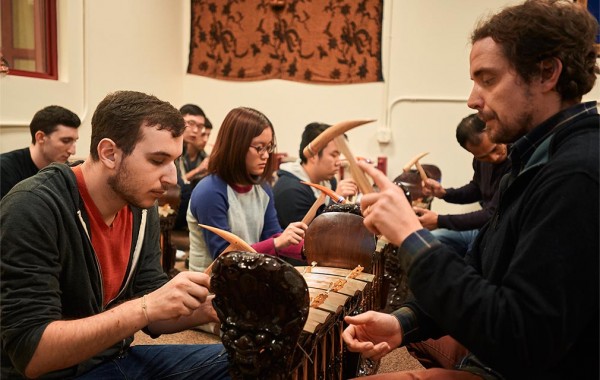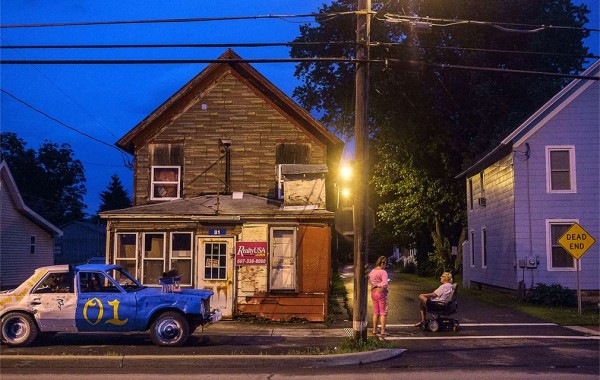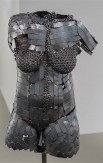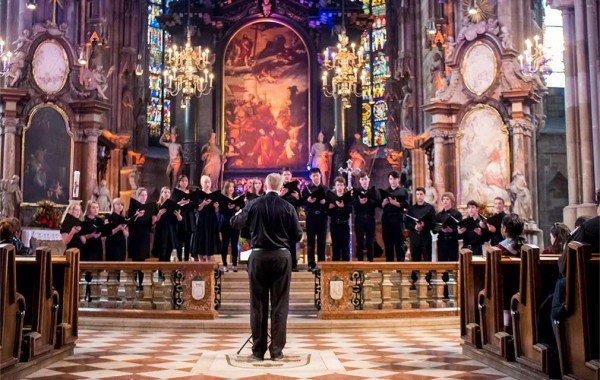A wonder(ous) workshop
A modern interpretation of an early Renaissance concept brought together peculiar pieces of community-created art this past spring. The 16th-century “cabinet of curiosities” functioned as a kind of encyclopedic microcosm of the world, combining specimens, diagrams, and illustrations from a plethora of disciplines; many specialists regard them as a precursor to museums.
Mark Dion, the Christian A. Johnson Endeavor Foundation Artist in Residence, invited students, professors, and area residents to fashion individual sculptures and paint them neon green in what he called the Phantom Museum Wonder Workshop. The finished products (many of them fauna and flora) were then displayed in a cabinet made by Daniel Stoltzfus of Custom Woodcraft in nearby Munnsville.
Dion modeled his career on the ideal that “the job of the artist is to go against the grain of dominant culture, to challenge perception and convention.” His particular interest lies in a vision to give “new life to objects from the past, ones recorded through engravings of cabinets of curiosities of long ago, by recreating them in the present,” explained Ellen Rogers, a Colgate professor, local artist, and former wildlife veterinarian who was involved in the workshop from start to finish.
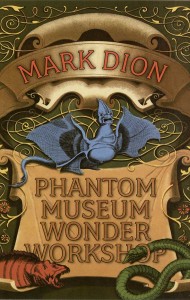
“Developing a project with a [university] and being the artist in residence is a little bit different than having a normal exhibition,” said Dion. “You want to do something that engages the students and gives them a little taste of the culture of being an artist and what it means to make things.”
“There were people of all different ages working on this project — that made it really beautiful,” said Denise Stillwaggon Leone, a Hamilton resident who specializes in architectural art glass. “I’m in my 60s, my son is in his 20s, and there are kids from Colgate who are 18. We were all working together to realize a project that was lots of fun.”
The final project was on display in Clifford Gallery from March 25 to April 10.
Watch how it took shape:
— Story by Emma Loftus ’16; top photo by Mark Williams
Gamelan style
If you walked into James C. Colgate Hall on a Monday afternoon in the spring, you might have heard unfamiliar yet intriguing musical sounds flowing out of classroom 209. That would have been Colgate’s new Balinese Gamelan Ensemble rehearsing.
Traditional music of Java and Bali in Indonesia, Gamelan predominantly features percussive instruments — most commonly different types of metallophones and hand-played drums that register the beat.
“The first thing I thought of when I came to Colgate was to start a Gamelan course,” said visiting professor Peter Steele, who has studied the music, instruments, and Balinese culture for 14 years. “It offers a nice complement to standard Western music.”
Most of the 13 student musicians didn’t have any experience with Gamelan music when they started rehearsing in February. Steele let the students try all the instruments and choose their own. “I wanted them to see the ensemble from different perspectives,” he explained.
There isn’t notation or sheet music, so the students learned by ear. They recorded rehearsals to help remember the music and practiced at home.
“The hardest part is the damping,” said Jeremy Bayer ’15 of the technique in which the musician dampens the previous note while playing the next.
“You have to be very quick,” added Jade Hoang ’17, “and it’s easy to make mistakes.”
Steele admitted being surprised by the students’ enthusiasm. “I didn’t know what they would think of it because it’s unlike anything they’ve heard before,” he said. “But they put a lot of hard work into it, and they all seemed focused and interested.”
The professor invited guest artist I Dewa Ketut Alit to compose a piece for the ensemble’s concert on April 27 in Brehmer Theater. “Alit writes very forward-thinking, experimental music,” said Steele. “It’s challenging to both the audience and the musicians.”
— Story by Iris Chen ’17; photo by Zoe Zhong ’17
Beauty in austerity
Photographer Tommy Brown ’79 has made a career through noticing the artistic value in things that others regard as mundane. A resident of Sherburne, N.Y., Brown captures the charm of rural central New York in images that encapsulate the serenity, simplicity, and sometimes neglected nature of his surroundings.
A collection of his photographs, titled A Burdened Pilgrimage, went on display in Case Library in January, and it will remain there for a year. The images include a range of landscapes, buildings, and people. Yet, Brown sees more than fields, barns, and central New Yorkers — he considers them inspiration for his visual “poetry.”
The collection includes works such as Dead End (pictured above), taken outside of a dilapidated home as dusk falls over the Chenango Valley. Flag features a twisted American flag in front of a partially painted home. Moreover, Revival shows a group of men raising their hands in awe at a demolition derby. Others have different but complementary themes.
Most of the photographs featured in the exhibition were taken within 10 miles of his home, but a few were shot on the North Fork of Long Island. As Brown said, “Pictures are everywhere.”
“There’s a realness in Tommy’s photography,” said art collector Paul Schupf ’58, who curated the exhibition. “It’s not glorifying, it doesn’t try to make it more beautiful than it is, and it’s not condescending, either. It just is what it is.”
As a Colgate student, Brown majored in art, then earned his master’s degree in photography from the Yale School of Art, which accepts only seven applicants per year. He has been a professional photographer for more than 35 years.
See more of his work at tommybrownpictures.com.
— Emma Loftus ’16
“The Infinite Dance” delights
What do J.S. Bach’s Partitas and traditional Chinese erhu (violin) music have in common? For one thing, a new concerto, called by one reviewer “quite original” with “soaring melodic loveliness” and “magical” effect — a “minor masterpiece.”
But for music professor and composer Zhou Tian, a deeper commonality served as his inspiration: both are musical forms inspired by dance.
“I am fascinated by the frequently similar energy … even though their musical roots cannot be more different: partitas were composed based on matured Western music theory, while erhu music is often freely improvised,” Zhou explained.
“Being a mixture of cultures myself, I wanted to add a new perspective to the mix, and to convey a sense of continuity of musical ideas from my cultural roots but presented with modern romanticism and energy.” So, he subtitled his concerto “The Infinite Dance.”
Zhou was also inspired by the instrument: having always loved its sound, and with his father and his wife both being violinists, “composing this piece felt like a release of that love.”
The 25-minute work consists of three movements, and, in addition to the typical string, wind, brass, and percussion sections in the orchestral accompaniment, Zhou’s score calls for instruments heard less frequently in a string concerto, from vibraphone, harp, and glockenspiel to crotales, tam-tam, and snare drum.
Zhou composed “The Infinite Dance” for violinist Caroline Goulding, who premiered it with conductor Stewart Robertson and the Atlantic Classical Orchestra in celebration of the orchestra’s 25th anniversary, via a commission underwritten by the Rappaport Foundation.
All four of its premiere performances, in Palm Beach and Stuart, Fla., in mid-April, received standing ovations.
Senior art
This year, there were eight studio art majors — all of whom happened to be women. In their final senior projects, they explored themes such as nature, the human body, architecture, memories, and space. Here’s a taste:
Jessica – Olivia – Nimra – Jenna – Regina – Mabel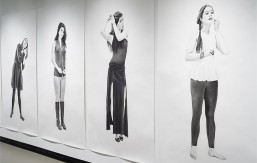
Charcoal on stonehenge paper
“Women are constantly negotiating their image. This work represents the extent to which a woman is pressured to measure her value by her appearance, but it also shows just how little of a person can be represented by their image alone.”
— Miri Reinhold
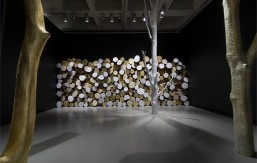
I saw the forest, I saw the trees
Birch, maple, and fir treeswax; gold leaf; and enamel paint
“This project began with a selection of material and grew from there. I am interested in the process of making itself … choosing a material and altering, modifying, and manipulating it to the point that the focus becomes what it looks like rather than what it actually is.”
— Katherine Norbom
“The female body is frequently described as soft and delicate; however, my focus for this sculpture was to use an abstraction of the muscular system to highlight the strength that is often overlooked when thinking of the stereotypical female form.”
— Alyssa Chaulklin
Sound of music
In May, the Colgate University Chorus had the opportunity to perform the program for our spring concert in the cities where the musical pieces would have originally been heard. During the nine-day tour, we held concerts in Prague, Bratislava, Vienna, and Budapest.
The program included Mass in D Major by the Bohemian composer Antonin Dvorak; Two Motets (Op.74) by Johannes Brahms, who spent most of his career in Austria; a piece by Hungarian composer Franz Liszt; and three works by American composers as cultural exchange.
“Each concert was a fantastic learning opportunity because we had to make adjustments for each performance space,” said choral director Ryan Endris.
The first concert was held in St. Savior’s Church, the oldest Protestant church in Prague. Although it had been three weeks since we’d last rehearsed, everyone was excited and well prepared. “It was great coming back together and singing as a group,” said Amanda James ’17. Approximately 200 people attended, giving the tour a great start.
There was an unforeseen hiccup at the Jesuit Church of the Holy Redeemer in Bratislava when our pre-concert recital was interrupted by an unexpected Mass and we had to quietly step out. “I was incredibly impressed by the professionalism of the students,” said Endris, “and their ability to [still] give an outstanding performance.”
The surprise and confusion in Bratislava was soon washed over by the recital in the Stephansdom, one of the most important religious buildings in Vienna. “It was so cool to be able to sing in such a musically historic space,” said David Wall ’18. Also, the cathedral’s massive scale was vastly different from any other place we’d sung in. “It was interesting to experience the acoustics,” said David Huang ’16.
For Lydia Mesler ’15, the final concert, in St. Michael’s Church in Budapest, was her favorite of the four, “because the crowd was so great.” The audience gave slow, steady applause, which, according to our trip organizer in Budapest, represented the highest praise given to a performance.
“We all realized that it was the last time that this group of people would ever sing together,” said Christy Mills ’17. “From that came the drive to do our best.”
A dinner cruise on the Danube after our Budapest concert marked the end of the tour. We gave cheers for friendship and music.
Check out our tour blog and watch performance videos:
— Iris Chen ’17


